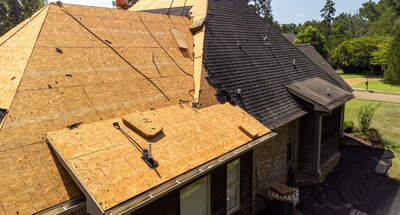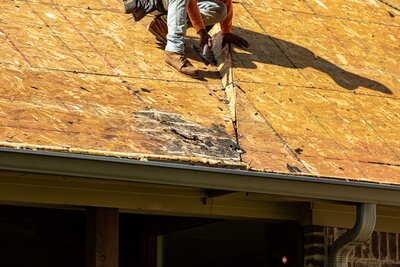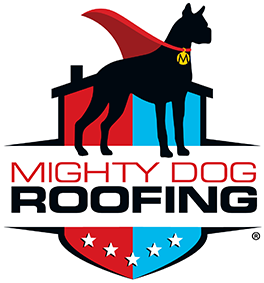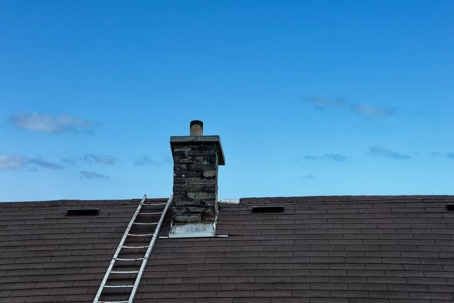What is Roof Decking? | Types of Roof Decking and Assessment Process
Roof Decking - Definition, Materials, and Benefits

Roof decking, also known as sheathing, is the foundation layer of a roofing system. It is typically made of wood (such as plywood or oriented strand board) or a composite material. It is installed over the roof's framing, creating a solid and level surface for the roofing materials.
Roof decking is essential for a safe, reliable roofing system. It supports your roof under extra weight, like snow. Constructing a level roof deck will ensure the smooth installation of roofing materials. Your roof will also be safer and more accessible with a sturdy roof deck.
Let’s discuss the various roof decking materials available.
Types Of Roof Decking
Before you choose your roof decking, you should familiarize yourself with the various types. A professional roofer can ensure the materials you choose suit your roofing project. Several factors will determine the type of roof decking you should have, like whether you are installing a new roof for a commercial or residential space.
Plywood
Based on our experience with previous clients, plywood remains one of the top choices for roof decking. It contains thin layers of wood veneer glued together, creating a strong, durable, lightweight material. You will find high-quality panels with smooth surfaces or low-grade panels with visible knots and imperfections.
Oriented Strand Board
Oriented Strand Board (OSB) proves cost-effective and durable, making it an excellent alternative to plywood roof decking. Manufacturers craft OSB by compressing and bonding wood strands, creating a powerful, long-lasting panel. The beauty of OSB lies in its versatility—it comes in various thicknesses and grades, allowing for a custom-tailored roof.
Plank
Planks are long, flat, rectangular pieces of timber with parallel faces. Wooden planks come in two different sizes: 1x6 and 1x8. They are typically made of solid-sawn timber, although some newer planks include metal and engineered wood.
Metal
We often install metal roof decking for commercial and industrial buildings with flat or low-slope roofing systems. Clients choose steel or aluminum metal roof decking because of its durability and fire resistance.
Are Roof Sheathing And Decking The Same Thing?
Even though some roofers prefer one name over the other, roof decking and sheathing are the same. Both terms refer to the flat wood boards that form the base of your entire roof and secure the joists across your home. When installing a new roof, our experts usually nail or staple the underlayment and shingles directly to the decking.
Benefits Of Roof Decking
Roof decking plays a vital role in the roofing system. It provides several benefits, like ensuring the long-lasting strength of your new roof.
Here are some of the critical advantages of well-built roof decking:
Better Structural Support
Roof decking serves as a sturdy base for your roofing structure, ensuring even weight distribution and supporting additional loads. A solid, stable roof deck will protect your home for years, making it an excellent investment.
Improved Roof Stability
With a well-maintained roof deck, you will not have to worry about your roof sagging or collapsing. A high-quality roof deck will save you money on expensive repairs or a roof replacement.
Barrier Against The Elements
Roof decking safeguards your home against rain, snow, strong winds, and other extreme weather conditions. It acts as a final barrier against leaks, which could damage your ceiling and walls.
Enhanced Insulation
Perfectly installed roof decking will contribute to maintaining a comfortable indoor temperature. This layer of insulation will keep your home warm during winter and cool in the summer, resulting in more efficient energy consumption.
Versatility
Whether you have a commercial or residential building, you need roof decking. Fortunately, there are a variety of materials to choose from that allow us to customize your roof. Picking the best type of roof deck will save you time and money by ensuring your roof will last for decades.
Will My Roof Decking Need to Be Replaced?

It depends. If your roof decking is damaged or rotted, it will need to be replaced during a roof replacement process. However, the full condition of your decking often isn’t visible until the old shingles and underlayment are stripped.
Once exposed, a professional roofer will inspect the decking to determine if any sections need replacement. Fixing damaged decking is essential to ensure the stability of your new roof and prevent future leaks or structural problems.
5 Signs You May Need To Replace Your Roof Decking
As a property owner, you should take a keen interest in your roof decks to prevent a roof replacement. Suppose you see signs of rotting or degradation in your roof. Take proactive measures to prevent the problem from spreading and destroying your roof. Find some of the things that you should look for below.
1. Sagging
One of the most common signs of roof deck deterioration is when your roof starts to sag in certain places. To solve this issue and prevent further damage, you should seek professional help to replace the damaged section.
2. Discoloration
Keep an eye out for discoloration. If you notice dark spots or stains on your roof, it could indicate water damage or a rotten deck. Moisture infiltration typically causes discoloration and compromises your roof's structural condition.
3. Roof Leaks
If you detect water leaking or observe visible water stains on your ceilings, your deck has suffered damage. Pay attention to these signs because leaks will rot your deck. Ask an expert for help repairing roof leaks or replacing your roof immediately.
4. Cracks Or Splits
Inspect your roof for visible cracks or splits. These signs occur due to age, extreme weather, or excessive exposure to humidity. Cracked or split decking diminishes its ability to support your roof and may necessitate a replacement.
5. Mold Or Mildew
Mold and mildew serve as yet another sign that your roof decking has moisture-related issues. Dealing with it requires swift action to prevent more damage and avoid health risks.
Secure Your Roof's Foundation With Mighty Dog Roofing
Now you understand the different types of roof decking, their benefits, and signs of damage. Whether you intend to build a new roof or replace your old one, the best way to ensure the safety and longevity of your roof deck is to consult the experts for roof inspections. Call Mighty Dog Roofing at (833) MIGHTY-4 to schedule a consultation today!


